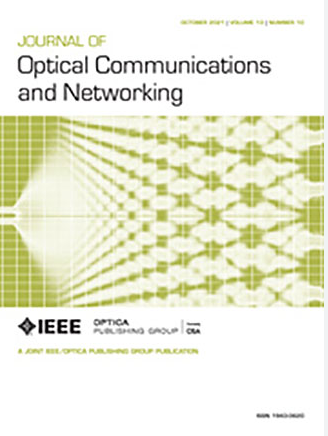Mapping-finding input-parameter refinement paradigm for a dynamic multiband optical network digital twin: the Raman amplifier modeling case
IF 4
2区 计算机科学
Q1 COMPUTER SCIENCE, HARDWARE & ARCHITECTURE
引用次数: 0
Abstract
Accurate quality-of-transmission (QoT) estimation tools are crucial to building digital twins (DTs) for optical networks. However, the input-parameter inaccuracy deteriorates the estimation accuracy of the physical models. To address this problem, an input-parameter refinement (IR) paradigm aiming at finding the mappings from uncertain parameters to their corresponding true values is proposed. The primary advantage of the IR paradigm, as demonstrated in this study for Raman amplifiers (RAs), lies in its applicability to dynamic optical networks, where system parameters such as loading conditions and optical device configurations are subject to frequent variations. The use of the proposed paradigm to refine the model of RAs is discussed in detail, while its applicability to other types of devices requires further investigation. The inaccuracy of fiber parameters, signal power, and pump power are taken into account. The particle swarm optimization (PSO) algorithm is utilized to address the problem of the coupling of these parameter inaccuracies. Experiments over a C + L band are conducted. In a single-span scenario, results show the proposed IR scheme can lower the physics-based RA model’s mean prediction error from动态多波段光网络数字孪生的映射-查找输入参数细化范例:拉曼放大器建模案例
精确的传输质量(QoT)估算工具对于构建光网络数字孪生(DT)至关重要。然而,输入参数不准确会降低物理模型的估计精度。为解决这一问题,我们提出了一种输入参数细化(IR)范例,旨在找到不确定参数与其相应真实值之间的映射关系。正如本研究针对拉曼放大器(RA)所展示的那样,IR 范式的主要优势在于它适用于动态光网络,在动态光网络中,加载条件和光学器件配置等系统参数会频繁变化。本文详细讨论了如何利用所提出的范例来完善拉曼放大器模型,同时还需要进一步研究该范例对其他类型设备的适用性。光纤参数、信号功率和泵浦功率的不准确性已被考虑在内。粒子群优化(PSO)算法用于解决这些参数不准确性的耦合问题。在 C + L 波段上进行了实验。在单跨场景中,结果表明所提出的 IR 方案可以将基于物理的 RA 模型的平均预测误差从 ${\sim}{0.92}\;{\rm dB}$ 降低到 ${\sim}{0.20}\;{\rm dB}$ 并将最大绝对误差(MAE)从 ${\sim}{3.09}\;{\rm dB}$ 降低到 ${\sim}{1.12}\;{\rm dB}$ 。当应用于双跨场景时,所提出的 IR 方案也表现出很高的精度,这表明它可以扩展到多跨光复用段 (OMS) 场景。此外,我们还证明了所提出的红外方案还能有效提高机器学习(ML)模型的精度。我们提出了一种基于红外辅助 ML 的模型训练方案。该方案在真实系统数据收集有限的情况下具有显著优势。有了所提出的红外范例,基于物理的模型和基于 ML 的模型都能在未来的动态多频带光网络中得到实际应用。
本文章由计算机程序翻译,如有差异,请以英文原文为准。
求助全文
约1分钟内获得全文
求助全文
来源期刊
CiteScore
9.40
自引率
16.00%
发文量
104
审稿时长
4 months
期刊介绍:
The scope of the Journal includes advances in the state-of-the-art of optical networking science, technology, and engineering. Both theoretical contributions (including new techniques, concepts, analyses, and economic studies) and practical contributions (including optical networking experiments, prototypes, and new applications) are encouraged. Subareas of interest include the architecture and design of optical networks, optical network survivability and security, software-defined optical networking, elastic optical networks, data and control plane advances, network management related innovation, and optical access networks. Enabling technologies and their applications are suitable topics only if the results are shown to directly impact optical networking beyond simple point-to-point networks.

 求助内容:
求助内容: 应助结果提醒方式:
应助结果提醒方式:


